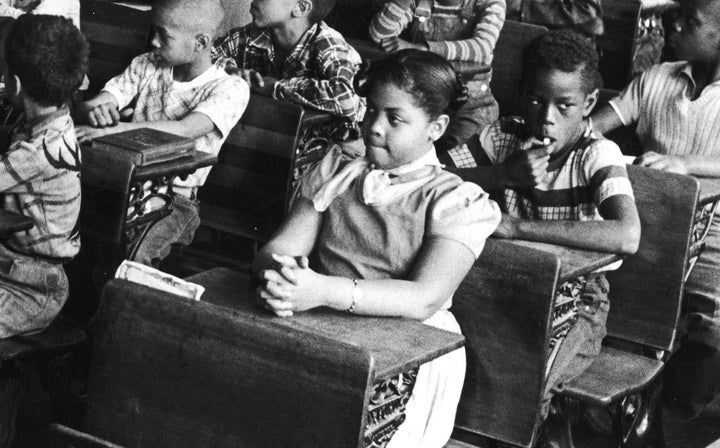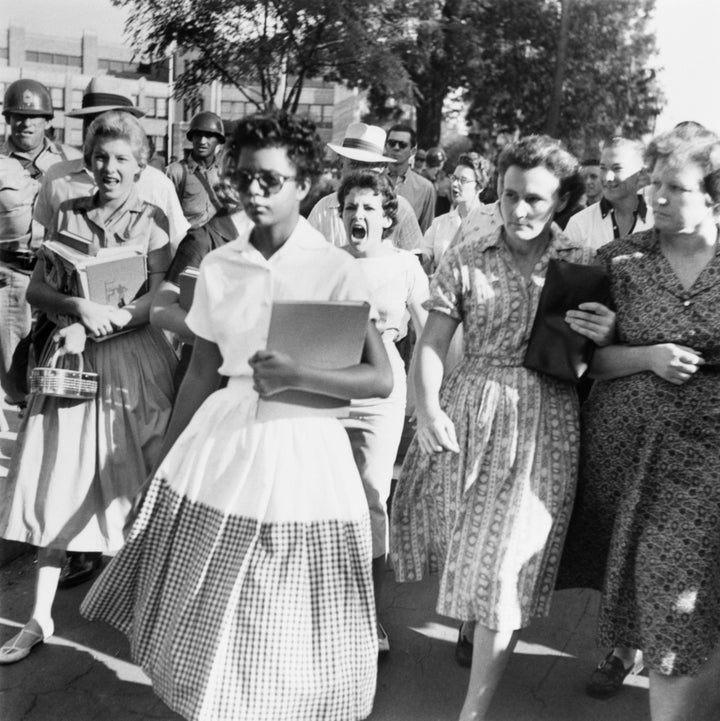
Linda Brown, whose name became representative of 1954’s landmark desegregation case Brown v. Board of Education, is dead. She died this week at the age of 75, and was rightly mourned as an icon of the civil rights struggle.
Brown v. Board of Education, however, died a long time ago. In fact, it arrived in the world almost stillborn. Its fragile life was threatened and its tender body gutted almost as soon as the U.S. Supreme Court handed down the words, “separate but equal has no place” in public education.
It’s easy to portray those who went after Brown as oafish, cross-burning Klansmen. It’s simple to lay the decision’s demise at the feet of the angry white housewives who surrounded, terrorized and screamed epithets at a 17-year-old who was just trying to go to school in peace a few years later. But what killed Brown was much more subtle, sophisticated and ― above all ― respectable than all that.
To destroy the landmark Supreme Court decision and ignore its admonition to integrate the schools “with all deliberate speed,” government officials had to practice a toxic combination of ruthlessness and timidity.
On one hand, there were those public servants who tenaciously defied the courts ― as well as laws, humanity and even national security ― to ensure that black children would not have access to quality education. They sat on school boards, in state legislatures, in governor’s mansions, and in Congress: in Virginia, they voted to shut down entire public school systems and provided taxpayer-funded tuition vouchers so that white children could continue on at all-white private academies. They crafted plans with the hallowed names of “freedom” and “choice” that allowed districts to chain black students to inferior schools and leave African-American parents with few options. They sat in Congress and vowed “massive resistance” to Brown and passed legislation that poured hundreds of millions of federal dollars into universities with whites-only admissions policies. They played the race card in politics, riling up the segregationists and ensuring the election of candidates whose only qualification was a vow to uphold white supremacy. Mississippi Governor Ross Barnett proudly blocked a Korean War air force veteran from enrolling in the state university on the GI Bill. In Alabama, Governor George Wallace gave his inaugural address in the same place as Confederate President Jefferson Davis and promised “segregation now, segregation tomorrow and segregation forever.”
That ruthlessness alone, however, would not have been enough to dispatch Brown. The destruction of desegregation also required a special kind of spinelessness from those who were supposed to uphold the laws and adhere to the norms of a democratic society. When the staunch segregationists launched “massive resistance” to Brown, they did not meet determined government opposition. Instead, they encountered a political system mired in moral, legal and political cowardice. Presidents, governors and upstanding citizens enveloped themselves in false equivalencies about “extremists on both sides.” They hid behind homilies about how “you can’t legislate morals” and “you can’t change the heart through legislation.”

President Dwight Eisenhower exemplified the failure to lead. Even before the Brown decision was announced, he tried to persuade Chief Justice Earl Warren that there was nothing wrong with segregation. “All [Southerners] are concerned about,” the president said, “is to see that their sweet little girls are not required to sit in school alongside big overgrown Negroes.” After the decision, Eisenhower, in a series of conversations with Reverend Billy Graham, desperately searched to find some examples of racial progress, no matter how impossible (black people getting voted onto the school board in 1950s Mississippi) or insignificant and irrelevant (a private, parochial school integrating) to temper the Court’s insistence on enforcing Brown. Something, anything, the president wrote, to get the judges to back off so that they would act “with complete regard for the sensibilities of the [white] population.”
The message from the White House was clear: the Brown decision was patently, inherently unfair to white people. It had nothing to do with the generational destruction of African Americans, who were languishing in Jim Crow schools that received, on average, 252 percent less funding than white schools ― and in some places in Mississippi, 1500 percent less. Brown recognized that unless African-American children were in the same schools as white children, they would never get the resources and facilities they deserved and to which they had a right. That was the harsh lesson of Plessy v. Ferguson. African-Americans would always be guaranteed “separate” but never get their hands on “equal.”
Prominent faith leader Rev. Graham also recognized that something had to be done. But whatever it was, it was not, he counseled, the responsibility of the President of the United States. He urged Eisenhower to “stay out of this bitter racial situation that is developing.”
That wasn’t possible. Eisenhower eventually sent the National Guard to Little Rock, Arkansas, in 1957 to quell the violent white response to nine black honors students who were attempting to desegregate Central High. Yet, even his actions were not a straightforward declaration of White House support for Brown. Arkansas Governor Earl Faubus had manipulated the situation in Little Rock to burnish his segregationist credentials and heighten his chances of re-election. He met with Eisenhower and promised to de-escalate the public spectacle of violence, which had made the U.S. the brunt of international scorn for being the Jim Crow leader of the Free World. Indeed, the Kremlin played and preyed on the racial divides in America’s vaunted democracy, taunting the United States for beating up black children simply because they wanted to be educated. Yet, despite the national security implications, Faubus reneged on his agreement with the president. It was that affront, and the international debacle unfolding on the pages of Pravda and gripping the attention of the world, that forced the decorated general to become a reluctant warrior in Little Rock. But he was never defending Brown itself. He was defending the international reputation of the United States.
In the end, the timidity of the White House and the recalcitrance of a Southern-dominated Congress left only the judiciary to uphold the law of the land ― and eventually, even the judiciary cracked. In a vicious one-two punch in the early 1970s, the court undermined Brown’s racial and financial underpinnings with the Milliken and Rodriguez decisions. Then underscored that full retreat in subsequent rulings over school integration in Louisville and Seattle.
Brown was dying even as it was born. In the face of vicious prejudice and complicit cowardice, it didn’t stand a chance. And now the woman for whom the landmark court case was fought is gone, too.
Linda Brown was the little girl who crossed a series of dangerous railroad tracks and busy streets to go to the Jim Crow school two miles away. She symbolized the horrific weight this nation demands children shoulder, and the battles they must so often fight to correct the failures and weaknesses of adults. And, sometimes, unfortunately, it just isn’t enough.
Carol Anderson is a historian and a professor of African-American Studies at Emory University. She is the author of White Rage: The Unspoken Truth of Our Racial Divide and the forthcoming One Person, No Vote: How Voter Suppression Is Destroying Our Democracy.
